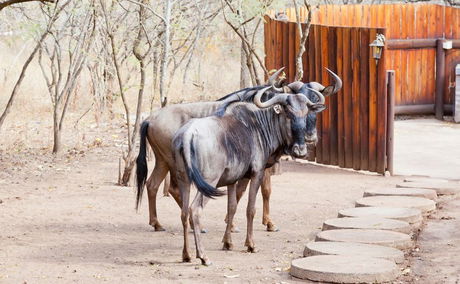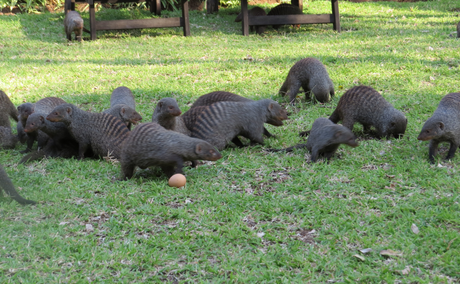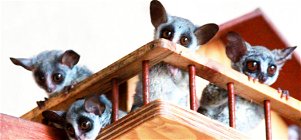Explore the role of wildebeest in Kruger National Park’s ecosystem. Learn about their behaviour, habitat, and their importance in the savanna.
Aardwolf: The Enigmatic Insectivore of Southern and Eastern Africa

Discover the aardwolf, a unique hyena cousin residing in southern and eastern Africa. This enigmatic creature's insectivorous diet, solitary lifestyle, and intriguing behaviors make it a fascinating and misunderstood member of the animal kingdom. Explore its remarkable adaptations and essential role in maintaining ecological balance, shedding light on the significance of conserving this captivating species.
In the expansive tapestry of Africa's wildlife, there exists a creature that defies easy categorisation - the aardwolf (Proteles cristatus).
The name Aardwolf means 'earth wolf' in Afrikaans and stems from its supposed dog-like features and its dietary habits of eating termites which it digs for in the ground and in the termite mounds.
Residing in the southern and eastern regions of the continent, the aardwolf is an enigmatic and relatively obscure member of the hyena family, making it the sole representative of its genus, Proteles. Its existence is a testament to the remarkable diversity of life that thrives on this vast continent.
The Aardwolf's Unusual Physique
When one first lays eyes upon an aardwolf, it's easy to mistake it for a small, slender dog at a distance. However, a closer examination reveals its unique characteristics. Aardwolves boast elongated, sinewy bodies supported by short legs. Their small, pointed ears and a long, bushy tail add to their distinctive profile. Most striking is their grizzled gray fur, marked by a conspicuous black stripe that runs along their back, resembling a natural tuxedo.
Aardwolves: The Insectivorous Gourmets
Aardwolves have a diet that sets them apart not only from other hyenas but from most mammals. They are consummate insectivores, with a penchant for termites, although ants and beetles also feature on their menu. Their unique adaptation for this diet is a lengthy, adhesive tongue used to deftly extract insects from their nests. Alongside this, they possess sharp claws, which, much like nature's pickaxe, allow them to excavate termite mounds with remarkable efficiency.
A Solitary Existence Underground
In the realm of social interactions, aardwolves stand out as loners. These creatures are solitary beings, inhabiting underground burrows as their homes. Their preference for the quietude of the night defines them as nocturnal animals. During daylight hours, they are seldom seen, as they prefer to curl up and slumber in the safety of their burrows. Interaction between aardwolves is minimal, with meaningful encounters occurring primarily during the mating season.
The Mystery of Reproduction
Aardwolves engage in mating once a year. After a gestation period of approximately 90 days, the female gives birth to a litter of 2-4 pups. These newborns enter the world blind and utterly reliant on their mother's care. The bond between mother and offspring is strong, with the young aardwolves staying with their mother for about six months as they gradually develop the skills necessary for survival.
Aardwolves and Human Relations
Aardwolves, unlike some of their larger hyena relatives, do not pose a threat to humans. In fact, they are often viewed as valuable contributors to their ecosystems. By keeping insect populations in check, they provide a natural form of pest control. However, it's worth noting that some farmers mistakenly consider them pests due to a lack of understanding about their role in maintaining ecological balance.
Fascinating Facts About Aardwolves
- Ecological Allies: Aardwolves may appear mysterious to some, but they are ecological allies. With their insatiable appetite for insects, they inadvertently contribute to pest control, making them valuable allies in the world of agriculture.
- Inaudible Conversations: Aardwolves are known for their unique ability to communicate through ultrasonic sounds, inaudible to human ears. These high-pitched calls are often used for secretive exchanges in their burrows, adding yet another layer of intrigue to their behaviour.
- Scent Trail Sorcery: When it comes to marking territory, aardwolves employ an ingenious strategy. They combine their saliva with soil to create a distinctive paste. This mixture is then applied strategically, leaving a scent trail that is both unusual and effective.
- Cryptic Burrows: Aardwolves take burrow design to a whole new level. Their underground homes feature multiple entrances and exits, creating a maze-like structure that adds an extra layer of protection against predators.
The Aardwolf: A Remarkable Anomaly
In the animal kingdom, aardwolves stand as a testament to nature's capacity for creating unique and specialised creatures. Their insectivorous lifestyle, solitary habits, and role in controlling insect populations underline their importance in the African ecosystems they inhabit. While some may misunderstand them as pests, a deeper appreciation for the aardwolf's ecological significance reveals a species that deserves both curiosity and conservation efforts. In the grand tapestry of Africa's wildlife, the aardwolf is a captivating thread worth unraveling.
To delve further into the world of aardwolves and explore their role in African ecosystems, we encourage you to visit the websites of organizations dedicated to their conservation, such as the African Wildlife Foundation and the Endangered Wildlife Trust. These remarkable creatures, with their distinctive habits and essential contributions to the environment, deserve our attention and protection.
Further Reading
Discover the quirky habits and social life of the banded mongoose. From synchronized births to snake-fighting skills, learn why these small mammals are Kruger's hidden gems.
Discover how termites, the hidden builders of Kruger National Park, create essential ecosystems with their mounds, recycling nutrients and supporting wildlife.










Share This Post